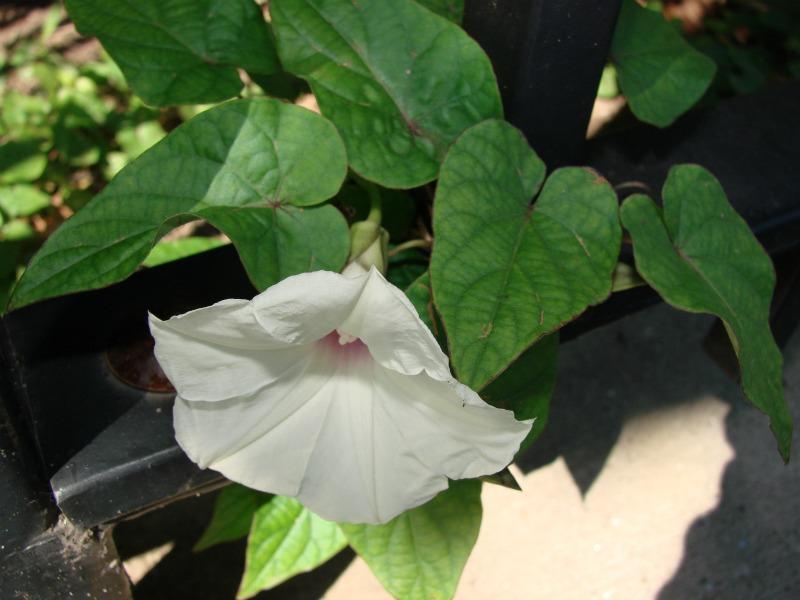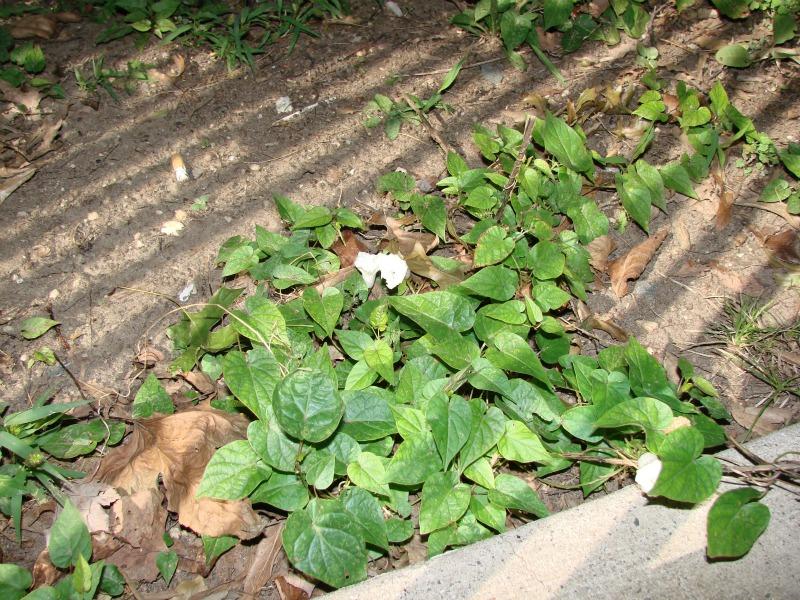Wild Potato Vine
Ipomoea pandurata (L.) G.F.W. Mey.
- Class
- Dicotyledoneae (Dicots)
- Family
- Convolvulaceae (Morning-Glory Family)
- State Protection
- Endangered
Listed as Endangered by New York State: in imminent danger of extirpation in New York. For animals, taking, importation, transportation, or possession is prohibited, except under license or permit. For plants, removal or damage without the consent of the landowner is prohibited.
- Federal Protection
- Not Listed
- State Conservation Status Rank
- S1
Critically Imperiled in New York - Especially vulnerable to disappearing from New York due to extreme rarity or other factors; typically 5 or fewer populations or locations in New York, very few individuals, very restricted range, very few remaining acres (or miles of stream), and/or very steep declines.
- Global Conservation Status Rank
- G5
Secure globally - Common in the world; widespread and abundant (but may be rare in some parts of its range).
Summary
Did you know?
The genus name comes from the Greek "ips homoios" meaning "resembling a worm". This refers to its vining habit (Wikipedia contributors). The species name comes from the resemblance of its leaves to the pandura, an ancient musical instrument originally from Persia and Assyria (Wikipedia contributors) and refers to the leaf shape of some of the leaves when they widen again toward the apex. The roots of this plant can grow very large and were used by Native Americans for food and medicine. At first bite the taste of sweet potato is followed by a bitter aftertaste (Wikipedia contributors).
State Ranking Justification
There are only two existing populations, and both of them are very small with fewer than 50 plants each. Both of them grow along the roadside and are not protected. There are 10 records from the late 1800s through 1968, but five of these are considered gone because their habitat, mostly from the New York City area, has been destroyed. Five of these populations have not been rechecked.
Short-term Trends
Neither population has been rechecked to determine short-term trends.
Long-term Trends
This plant has always been rare in New York, but half of the populations have been destroyed in the New York City area in the last 100 years because of development.
Conservation and Management
Threats
Roadside succession, development and improper vegetation management are threats.
Conservation Strategies and Management Practices
Proper landscape management must prevent succession from outcompeting plants, and they must also be protected from direct disturbance.
Research Needs
Research is needed to find out if plants can be propagated and populations augmented.
Habitat
Habitat
The documented locations for this species in New York have been in disturbed habitats, such as old field and road margins, hedgerows, and quarry edges, dominated by shrubs and vines (New York Natural Heritage Program 2010). Dry woods and thickets (Gleason & Cronquist 1991). Dry open or partly shaded soil (Fernald 1970).
Associated Ecological Communities
- Rock quarry
An excavation in bedrock from which building stone (e.g., limestone, sandstone, slate) has been removed. Vegetation may be sparse; plants may be rooted in crevices in the rock surface.
- Successional old field
A meadow dominated by forbs and grasses that occurs on sites that have been cleared and plowed (for farming or development), and then abandoned or only occasionally mowed.
Associated Species
- Ipomoea
- Parthenocissus
- Vitis
Range
New York State Distribution
This vine has a very scattered range across New York. There is one known occurrence south of Rochester and one on Staten Island. There are historical reports and specimens from Dutchess County south to the Bronx in the Hudson Valley, and also in far western New York in Erie and Cattaraugus counties.
Global Distribution
This vine extends from Southern New England and New Jersey west to Iowa and Missouri and Eastern Kansas and Oklahoma south to eastern Texas and Florida. It is rare in Michigan, Ontario, and New York where it reaches its northern limits.
Identification Comments
General Description
Ipomoea pandurata is a perennial, herbaceous vine in the same genus as the common morning glory. Its twining stems are glabrous or nearly so, and may grow up to 5 meters long, extending from large tuberous roots. The leaves are ovate with acuminate tips (or sometimes pandurate [fiddle-shaped]) and entire with deeply cordate bases, and are from 5 to 15 cm long. The flowers are on peduncles longer than the petioles, and arranged in terminal clusters of 1-7. The sepals are ovate or oblong, 13 to 20 mm long, and glabrous. The petals are fused together to form a funnel-shaped flower 5 to 8 cm long and 7 to 10 cm broad, and are white with red-purple centers (Gleason and Cronquist 1991).
Best Life Stage for Proper Identification
Stems with mature flowers are best for identification.
Similar Species
Ipomoea hederacea and I. purpurea's flowers both have ovaries with 3 locules and stigmas with 3 lobes, and their sepals are hairy on their lower halves. Ipomoea lacunosa has ciliate sepals and much smaller flowers (usually under 2 cm long).
Best Time to See
Ipomoea pandurata flowers from mid-July through mid-September.
- Flowering
The time of year you would expect to find Wild Potato Vine flowering in New York.
Wild Potato Vine Images
Taxonomy
Wild Potato Vine
Ipomoea pandurata (L.) G.F.W. Mey.
- Kingdom Plantae
- Phylum Anthophyta
- Class Dicotyledoneae
(Dicots)
- Order Solanales
- Family Convolvulaceae (Morning-Glory Family)
- Order Solanales
- Class Dicotyledoneae
(Dicots)
- Phylum Anthophyta
Additional Common Names
- Man-of-the-Earth
- Wild Potato-vine
Additional Resources
Best Identification Reference
Gleason, Henry A. and A. Cronquist. 1991. Manual of Vascular Plants of Northeastern United States and Adjacent Canada. The New York Botanical Garden, Bronx, New York. 910 pp.
Other References
Fernald, M.L. 1950. Gray's manual of botany. 8th edition. D. Van Nostrand, New York. 1632 pp.
Holmgren, Noel. 1998. The Illustrated Companion to Gleason and Cronquist's Manual. Illustrations of the Vascular Plants of Northeastern United States and Adjacent Canada. The New York Botanical Garden, Bronx, New York.
New York Natural Heritage Program. 2010. Biotics database. New York Natural Heritage Program. New York State Department of Environmental Conservation. Albany, NY.
New York Natural Heritage Program. 2024. New York Natural Heritage Program Databases. Albany, NY.
Weldy, T. and D. Werier. 2010. New York flora atlas. [S.M. Landry, K.N. Campbell, and L.D. Mabe (original application development), Florida Center for Community Design and Research http://www.fccdr.usf.edu/. University of South Florida http://www.usf.edu/]. New York Flora Association http://newyork.plantatlas.usf.edu/, Albany, New York
Links
About This Guide
Information for this guide was last updated on: February 25, 2011
Please cite this page as:
New York Natural Heritage Program. 2024.
Online Conservation Guide for
Ipomoea pandurata.
Available from: https://guides.nynhp.org/wild-potato-vine/.
Accessed July 27, 2024.

